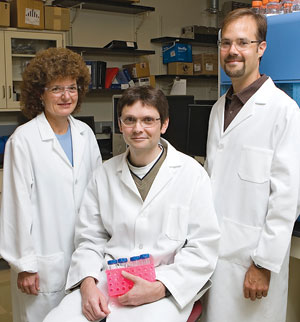Cells' trash yield scientific treasure

RESEARCH | A person’s trash can reveal valuable information, as detectives, historians and identity thieves well know. Likewise, researchers say, a cell’s “trash” may also yield certain treasures.
Using a new technique they developed, scientists at UD’s Delaware Biotechnology Institute have analyzed the cellular waste of one of the world’s most-studied plants and discovered formerly hidden relationships between genes and the small molecules that can turn them off.
The approach was devised by postdoctoral researcher Marcelo German, with Pamela Green, the Crawford H. Greenewalt Endowed Chair in Plant Molecular Biology, and Blake Meyers, associate professor of plant and soil sciences, and their research teams, and is reported in the prestigious scientific journal Nature Biotechnology. It also is highlighted, along with two related techniques that were developed almost simultaneously by other U.S. research teams, in a commentary in the journal’s “News and Views” by molecular biologists Ian Henderson and Steven Jacobsen from the University of California at Los Angeles.
The study, which was funded by the Department of Energy and the National Science Foundation, was undertaken in Arabidopsis thaliana, a member of the mustard family. The first flowering plant to have had all of its genetic material (“genome”) sequenced, Arabidopsis is regarded as the botanical equivalent of the fruit fly due to the relatively small size of its genome and the ease with which the plant can be cultured and grown in the lab.
The researchers’ focus was the cellular targets of tiny molecules of ribonucleic acid (RNA) known as microRNAs, which play a critical role in how a plant cell develops and responds to stress. MicroRNAs bind to messenger RNAs, which are longer molecules that carry instructions to the cells to make proteins.
“The microRNAs target messenger RNAs—they are out to destroy them—in plant cells,” Meyers says. In fact, the microRNAs direct enzymes to cut the messenger RNAs in two. The resulting decay products, which German calls “cell trash,” are the focus of the UD technique.
Rather than searching for the cleaved RNAs one by one in a tedious process that previously had been the standard, the technique collects all of this “cell trash” to analyze at once, saving researchers time and labor, while generating a rich data set for analysis.
“The approach will enable us to analyze RNA degradation products at a very large scale, identifying millions of molecules without bias and with a substantial reduction in labor and efforts,” Meyers says.
The “holistic” technique also will enable scientists to examine several regulatory pathways at once for a given stimulus versus just one, discovering novel networks of interactions, according to German.
“You could profile a mutant cell against a normal one and determine exactly what is happening and what enzymes are affected in decay processes,” he says. “The focus is changing. Work that used to take months, you can now do in a week.”
Currently, German is documenting an even faster method.
Originally from Argentina, German received his doctorate from the Hebrew University of Jerusalem in Israel. He says he was attracted to UD by the cell biology research being led by Green and Meyers, who have made internationally recognized strides in plant genetics, including studies of rice, the world’s top grain.
“I like to develop new things, to explore and discover. That is the most rewarding thing of all about being a scientist,” German says.
Article by Tracey Bryant





